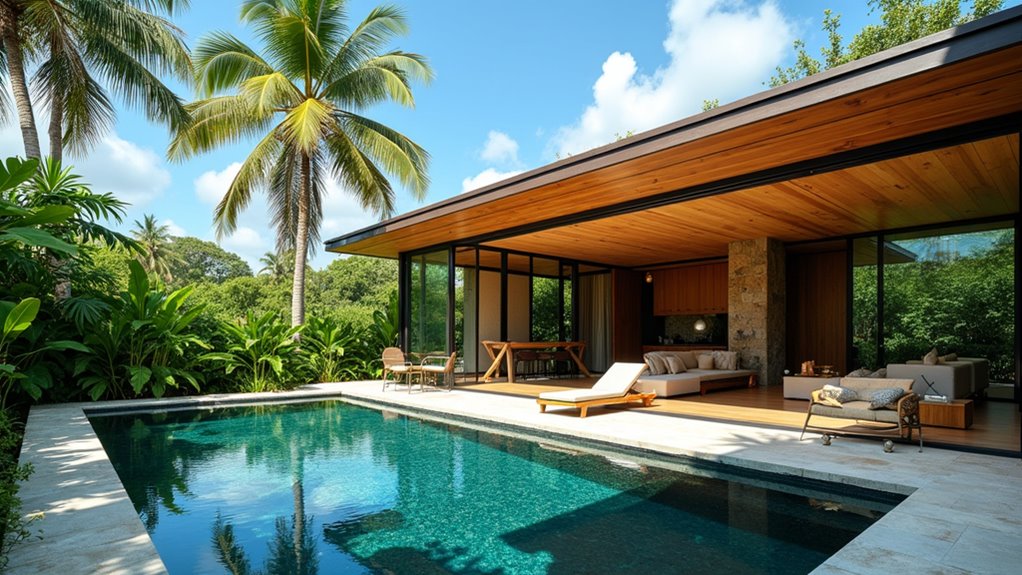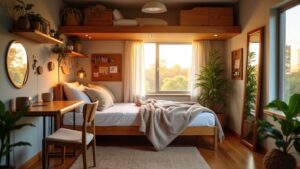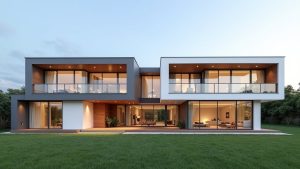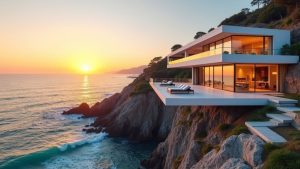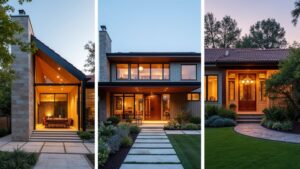Modern tropical house design embraces bold tropical foliage, natural materials, and vibrant colors to create serene, inviting spaces. Expansive glass walls and vertical gardens blur the line between indoors and outdoors. Minimalist aesthetics featuring clean lines and open-plan layouts prioritize comfort and connection with nature. Sustainable features like natural ventilation and rainwater harvesting enhance eco-friendliness. This harmonious blend offers a vibrant and balanced living experience. Explore further for additional inspiring ideas that elevate contemporary tropical living.
Key Takeaways
- Integrate bold tropical foliage in both indoor and outdoor spaces to enhance serenity and connection with nature.
- Utilize natural materials like sustainable bamboo and locally sourced woods for texture and warmth.
- Embrace vibrant color palettes with warm whites, turquoise, and coral accents to promote relaxation and playfulness.
- Design with minimalist aesthetics focusing on open-plan living, clean lines, and functional simplicity to connect spaces seamlessly.
- Incorporate sustainable and eco-friendly features such as natural ventilation and energy-efficient systems to minimize environmental impact.
Lush Greenery as Focal Points
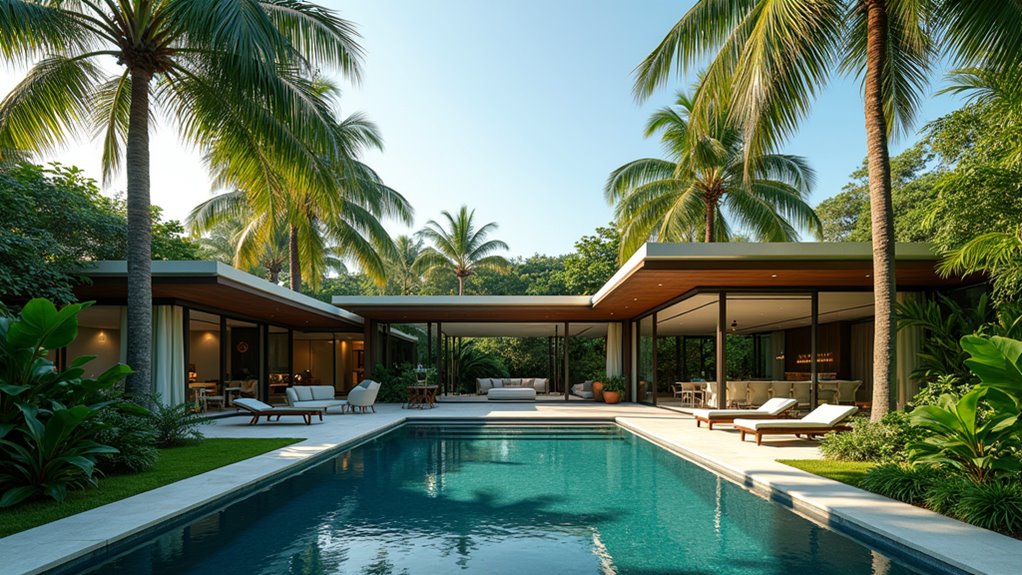
In tropical house design, lush greenery serves as a vibrant focal point that transforms both outdoor and indoor spaces into serene sanctuaries.
The incorporation of bold tropical foliage, such as philodendrons and anthuriums, heightens the appeal of interiors while promoting biophilic design principles. These plants not only purify the air but also enhance visual interest. By blending contemporary design with island living vibes, the overall aesthetic becomes even more inviting and cohesive. Incorporating elements of Tropical Modernism, such as expansive glass walls, further enhances the connection to the surrounding greenery and natural light. Additionally, integrating natural ventilation systems within the design can improve occupant comfort while reducing energy consumption.
Outdoor settings thrive with eye-catching elements like banana trees and bird of paradise flowers, creating dynamic backdrops.
Thoughtfully arranged vertical gardens and hanging planters emphasize the seamless flow between inside and out.
Pathways dotted with ferns and framed by climbing jasmine add intimacy, while water features entice wildlife, reinforcing the connection to nature.
Together, these verdant elements cultivate a cohesive tropical aesthetic.
Natural Materials With a Modern Twist
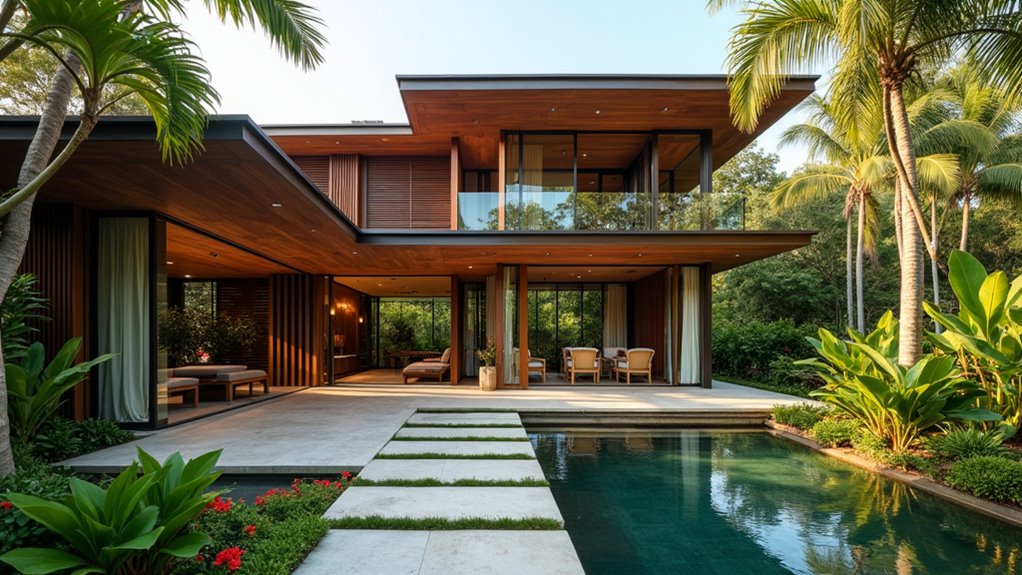
Emphasizing the harmonious interplay of nature and modern design, tropical house interiors increasingly embrace natural materials with a contemporary twist.
Sustainable bamboo innovations serve as a primary element, transforming spaces with their unique textures and eco-friendly qualities. Locally sourced woods and natural stone enhance warmth and establish a tactile connection with the surrounding environment.
Weatherproof finishes are applied to rattan and wicker, ensuring longevity against tropical climates, while jute textiles inject additional warmth.
Significantly, recycled plastics are creatively used, showcasing a commitment to sustainability. These materials not only define the aesthetic but also align with eco-conscious principles, offering a modern solution to traditional elements in tropical architecture, further blurring the lines between interior comfort and nature. Moreover, incorporating sustainable materials such as cross-laminated timber guarantees an eco-friendly approach to contemporary design.
Vibrant and Balanced Color Palettes
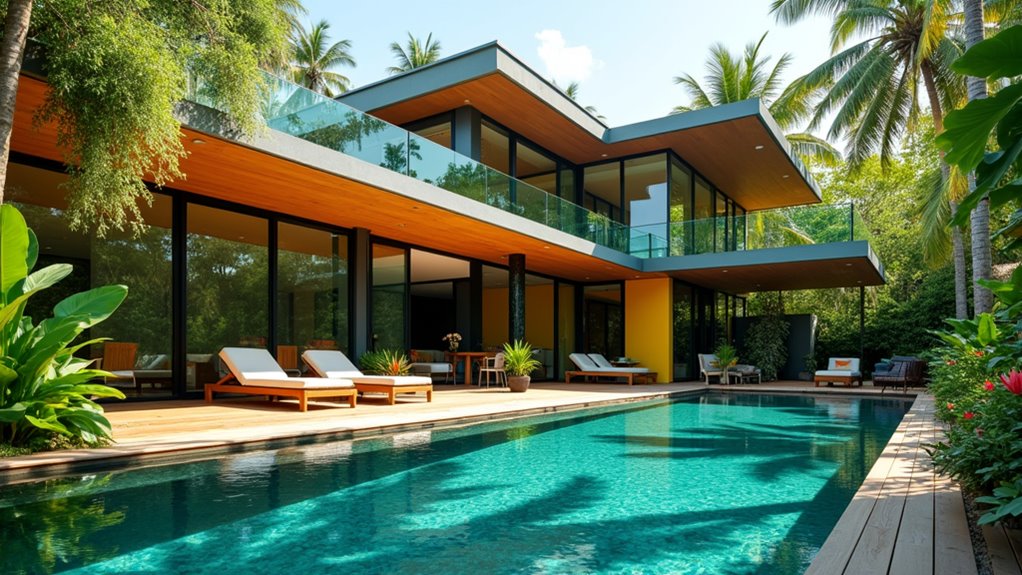
A vibrant and balanced color palette is essential for evoking the essence of tropical living, seamlessly merging tranquility with vitality.
By understanding color psychology and employing thoughtful accent strategies, designers can create invigorating yet harmonious spaces. Key elements include:
- Base Colors: Warm whites and muted neutrals provide airy foundations.
- Accent Choices: Vibrant hues like turquoise and coral infuse playfulness.
- Warm and Cool Tones: Combining sunset yellows with soothing greens fosters depth.
- Layering Techniques: Utilize patterned accents and contrasting trims to enhance visual interest.
This careful selection promotes relaxation, encourages outdoor connectivity, and enhances overall well-being, resulting in inviting environments that embody the spirit of tropical living without overwhelming the senses.
Minimalist Tropical Design Aesthetics

Blending simplicity with the vibrant essence of tropical living, minimalist tropical design aesthetics create serene environments that prioritize both comfort and functionality. This approach emphasizes functional simplicity, utilizing natural materials to cultivate an uncluttered, harmonious design. Open-plan living spaces seamlessly connect indoor areas with outdoor landscapes, enhanced by sliding glass doors and courtyards that invite nature inside. Architectural elements, such as pitched roofs and brise soleil, not only fulfill aesthetic desires but also respond effectively to tropical climates. The integration of lush greenery and water features further enhances design harmony, transforming spaces into tranquil retreats. In this style, clean lines prevail, showcasing a sophisticated minimalism that aligns with the organic beauty of the surrounding environment. Additionally, durable materials ensure longevity and structural integrity, which is crucial for the sustainability of these designs.
Sustainable and Eco-Friendly Features
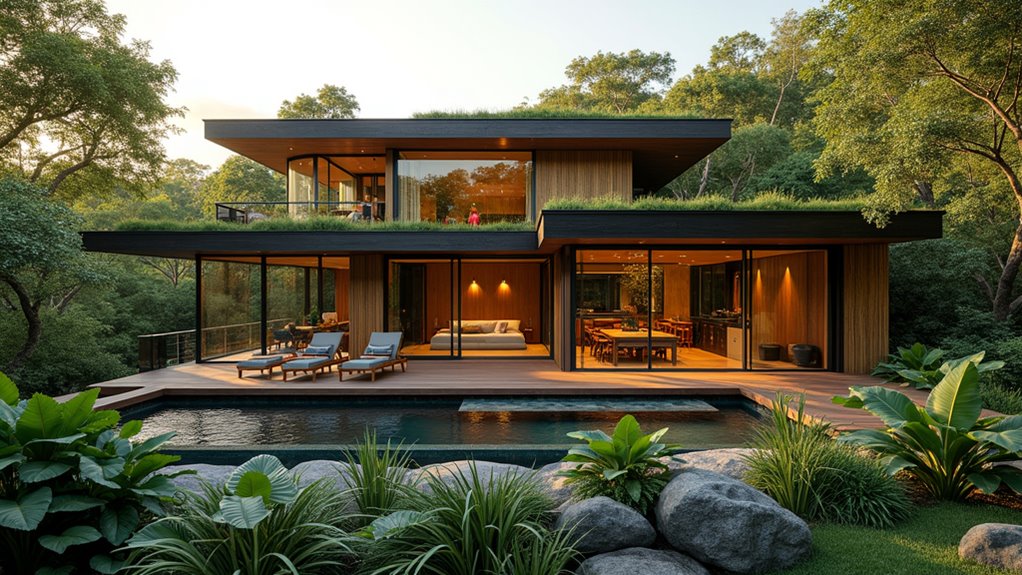
As sustainable living gains momentum, the integration of eco-friendly features in tropical house designs has become essential for creating harmonious environments. Emphasizing both water conservation and energy efficiency, homeowners increasingly opt for innovative, sustainable materials and technologies.
The rise of sustainable living is reshaping tropical house designs with eco-friendly features for better harmony with nature.
Key features include:
- Natural Ventilation: Utilizing operable windows and ceiling vents encourages airflow, reducing reliance on air conditioning.
- Energy-Efficient HVAC: Smart thermostats and efficient systems optimize cooling, minimizing energy consumption.
- Rainwater Harvesting: Collection systems not only conserve water but can also enhance landscaping aesthetics.
- Sustainable Materials: Bamboo flooring and reclaimed wood offer appealing alternatives that lessen environmental impact.
These elements create a balance between functionality and ecology, reflecting a modern approach to tropical architecture.
Statement Lighting and Bold Wall Treatments
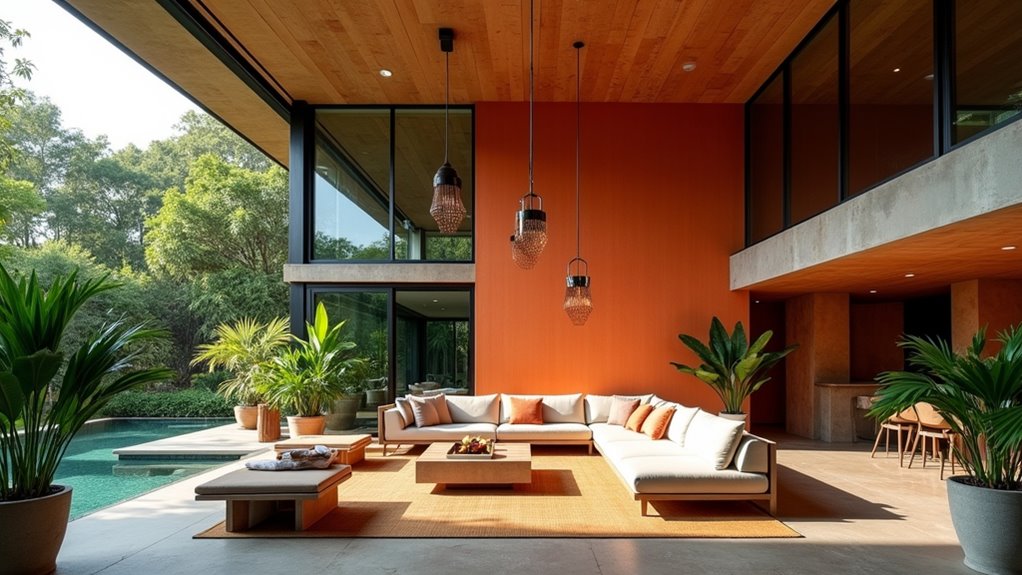
Whether crafting an inviting ambiance indoors or enhancing the exterior charm of a tropical retreat, statement lighting and bold wall treatments serve as integral design elements that elevate the overall aesthetic.
Rattan pendants and bamboo chandeliers embody tropical textures, infusing spaces with organic beauty. Accent fixtures such as seaglass lights and coral accents contribute vibrant pops of color reminiscent of coastal landscapes.
Bold wall treatments, featuring palm leaf patterns and tropical prints, invigorate interiors with lively motifs while bright color accents like turquoise or coral establish a dynamic visual contrast.
Incorporating natural textiles, like woven baskets, fosters depth and warmth. Together, these elements create a harmonious and captivating environment that reflects the spirit of tropical living.
Creating Seamless Indoor/Outdoor Spaces
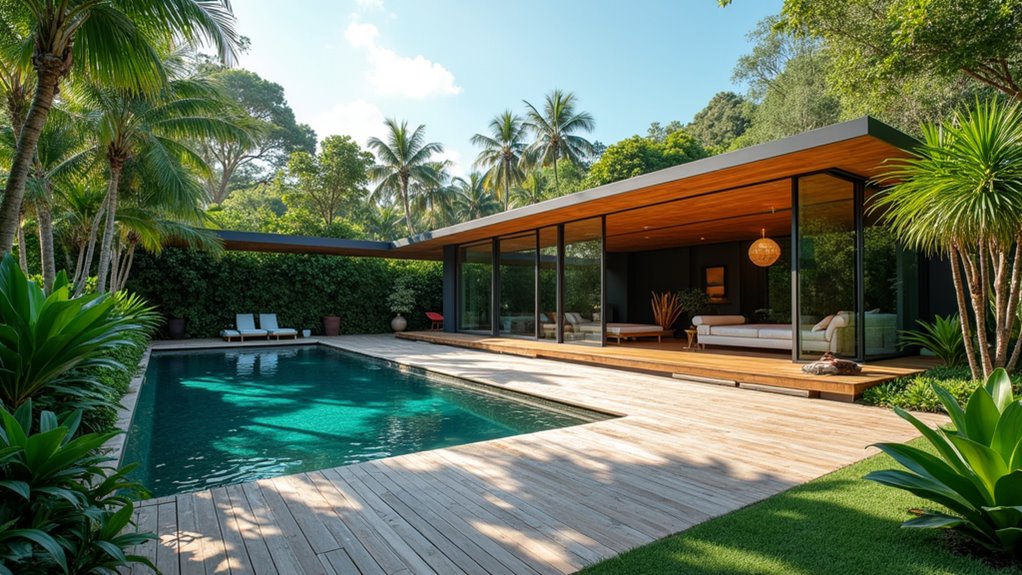
Creating seamless indoor/outdoor spaces embodies the essence of tropical living, where boundaries between nature and home dissipate, fostering a tranquil environment.
This design philosophy emphasizes an integrated experience with nature through:
- Expansive Windows: Large sliding glass doors allow abundant natural light and unobstructed views of lush landscapes.
- Open Air Patios: Outdoor areas extend living spaces, promoting engagement with the elements.
- Indoor Gardens: Strategic placements of greenery cultivate a serene ambiance that flows from outside to indoors.
- Natural Materials: Wood and stone are used in both building and outdoor furniture, enhancing the home’s warmth and connection to nature.
Such design choices create a harmonious blend of indoor comfort and outdoor beauty, essential for a modern tropical lifestyle.
